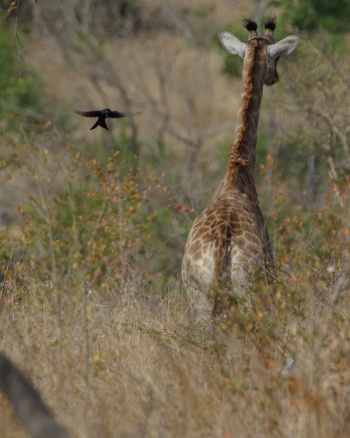Alternative name: African Drongo
Includes: Glossy-backed Drongo
- Dicrurus adsimilis
Identification
23–26 cm (9-10 in)
- Glossy black overall plumage
- Wings duller
- Large head
- Forked tail
- Heavy black bill
- Red eye
- Short legs
Female similar but duller
Variations
The populations in western and northern parts of the range (subspecies divaricatus and lugubris) are described as smaller with pale grey-buff inner webs of flight-feathers and a shallower tail fork. Formerly the population in Tanzania and much of Kenya were assigned to the nominate race, D. a. adsimilis now placed within the range of D. a. fugax. It is described as smaller with a more deeply forked tail.
Similar species
Differs from similar Velvet-mantled Drongo in having tail shorter than wing, a less deep tail fork, slightly less gloss and no pale rictal spot. Square-tailed Drongo and Shining Drongo are smaller and have a less forked tail.
Distribution
The Fork-tailed Drongo is a common and widespread resident breeder in Africa south of the Sahara, from Southwestern Mauritania south to Guinea , east to Niger and northeastern Nigeria (Lake Chad), east to Ethiopia, Eritrea, and Somalia, south to southern parts of South Africa.
Taxonomy

Photo © by Alan Manson
Cedara Farm, Pietermaritzburg, South Africa, 21 August 2007
Forms a superspecies with Black Drongo of Asia and was formerly regarded as conspecific. They were split in 2007 by Pasquet et al.[5]The combined pre-split species was known as "Common Drongo" or just "Drongo."
Subspecies
Clements recognizes these subspecies[1]:
- D. a. apivorus:
- Southeast Gabon and adjacent Congo, patchily in Democratic Republic of the Congo, Angola, Zambia, Namibia, Botswana and northern South Africa (northern Northern Cape to Limpopo)
- D. a. jubaensis: (formerly considered a junior synonym of D. a. divaricatus)
- Ethiopia, Eritrea, and Somalia
- D. a. fugax:
- D. a. adsimilis:
- Eastern and southern South Africa (southwestern Western Cape north to southern Mpumalanga and KwaZulu-Natal), Lesotho, and western eSwatini
- D. a. divaricatus:
- Southwestern Mauritania south to Guinea, east to southeastern Niger and northeastern Nigeria (Lake Chad)
- D. a. lugubris:
Subspecies D. a. divaricatus (with lugubris) was recognized as a separate species Glossy-backed Drongo.[6]
Habitat

Photo © by AHH
Kruger National Park, South Africa, 9 July 2007
Woodlands including riverine woodlands, moist and arid savanna, forest edges and grassland or fynbos with available perches, plantations of alien trees, gardens, farmyards and town parks.
Behaviour
Actions
Sits very upright whilst perched prominently, like a shrike. An aggressive bird, which will attack much larger species, including birds of prey, snakes and humans, if their nest or young are threatened.
Diet
Their prey is taken aerially and on the ground, and includes flying insects, moths and bees; most often they will sit on a branch and sally out from there, but it may also be sitting on the ground. They are often seen taking prey disturbed by large animals or bush fires. They also often steal food from other birds, and have been known to steal food from suricates (Meerkats) and Southern Pied Babblers by sounding false alarms.
Breeding
Monogamous, solitary nester building thin-walled, strongly woven cup nests in high tree-forks. Two to five eggs of highly varying colour.
Vocalisation
The call is a metallic strink-strink. They are also excellent mimics.
Movements
Resident; possibly some short-distance movements in southern part of range.
References
- Clements, J. F., P. C. Rasmussen, T. S. Schulenberg, M. J. Iliff, T. A. Fredericks, J. A. Gerbracht, D. Lepage, A. Spencer, S. M. Billerman, B. L. Sullivan, and C. L. Wood. 2023. The eBird/Clements checklist of Birds of the World: v2023. Downloaded from https://www.birds.cornell.edu/clementschecklist/download/
- Gill, F, D Donsker, and P Rasmussen (Eds). 2024. IOC World Bird List (v 14.2). Doi 10.14344/IOC.ML.14.2. http://www.worldbirdnames.org/
- Birdforum member observations
- Kirwan, G. M., G. Rocamora, and D. Yeatman-Berthelot (2023). Fork-tailed Drongo (Dicrurus adsimilis), version 2.0. In Birds of the World (N. D. Sly, Editor). Cornell Lab of Ornithology, Ithaca, NY, USA. https://doi.org/10.2173/bow.fotdro5.02
- Pasquet, Eric; Jean-Marc Pons;Jerome Fuchs; Corinne Cruaud & Vincent Bretagnolle (2007). "Evolutionary history and biogeography of the drongos (Dicruridae), a tropical Old World clade of corvoid passerines." Molecular Phylogenetics and Evolution 45 (1): 158–167. PDF
- Fuchs, J, De Swardt, DH, Oatley, G, Fjeldså, J, Bowie, RCK. (2018) Habitat‐driven diversification, hybridization and cryptic diversity in the Fork‐tailed Drongo (Passeriformes: Dicruridae: Dicrurus adsimilis). Zool Scr. 47:266– 284. https://doi.org/10.1111/zsc.12274
Recommended Citation
- BirdForum Opus contributors. (2025) Fork-tailed Drongo. In: BirdForum, the forum for wild birds and birding. Retrieved 15 May 2025 from https://www.birdforum.net/opus/Fork-tailed_Drongo
External Links
GSearch checked for 2020 platform.1




